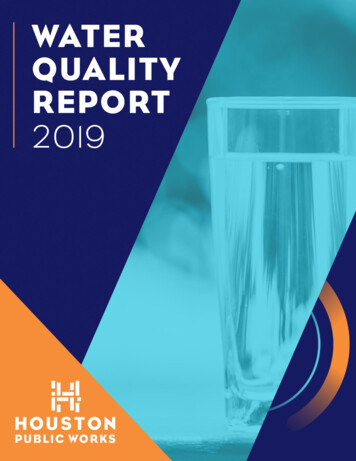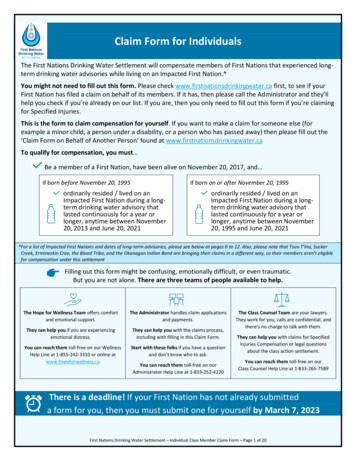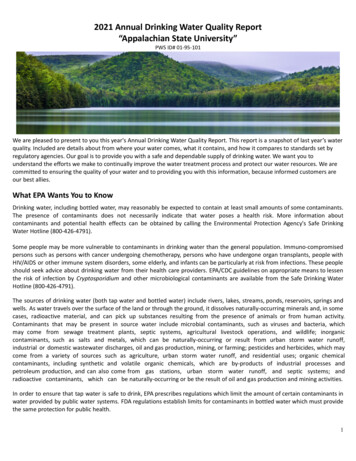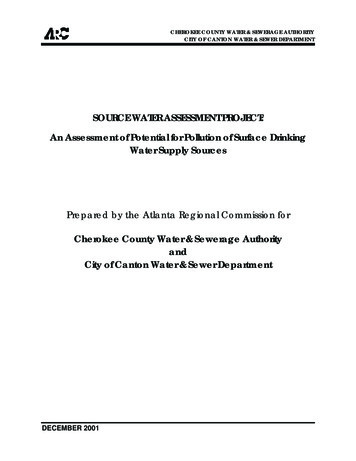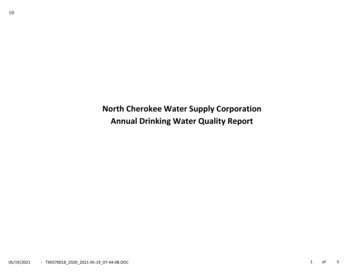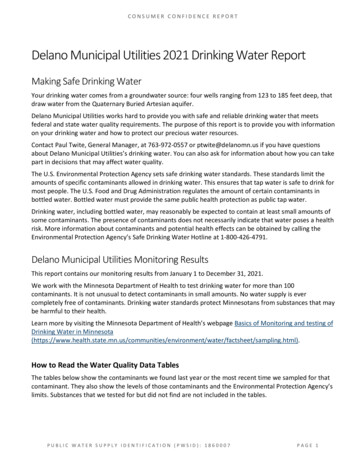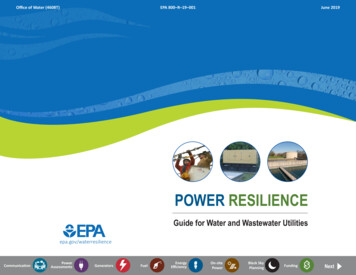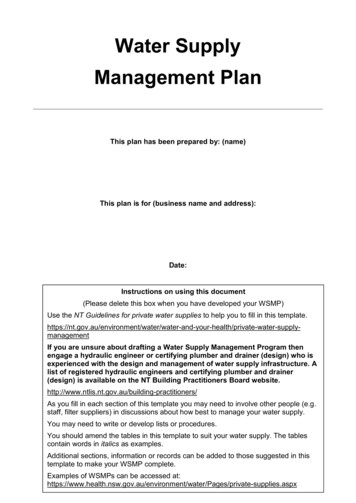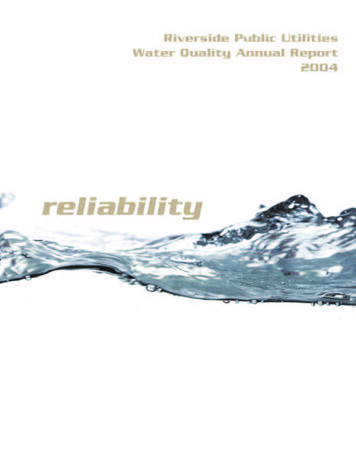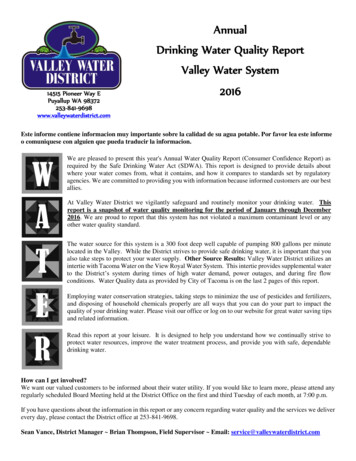
Transcription
AnnualDrinking Water Quality ReportValley Water System14515 Pioneer Way EPuyallup WA te informe contiene informacion muy importante sobre la calidad de su agua potable. Por favor lea este informeo comuniquese con alguien que pueda traducir la informacion.We are pleased to present this year's Annual Water Quality Report (Consumer Confidence Report) asrequired by the Safe Drinking Water Act (SDWA). This report is designed to provide details aboutwhere your water comes from, what it contains, and how it compares to standards set by regulatoryagencies. We are committed to providing you with information because informed customers are our bestallies.At Valley Water District we vigilantly safeguard and routinely monitor your drinking water. Thisreport is a snapshot of water quality monitoring for the period of January through December2016. We are proud to report that this system has not violated a maximum contaminant level or anyother water quality standard.The water source for this system is a 300 foot deep well capable of pumping 800 gallons per minutelocated in the Valley. While the District strives to provide safe drinking water, it is important that youalso take steps to protect your water supply. Other Source Results: Valley Water District utilizes anintertie with Tacoma Water on the View Royal Water System. This intertie provides supplemental waterto the District’s system during times of high water demand, power outages, and during fire flowconditions. Water Quality data as provided by City of Tacoma is on the last 2 pages of this report.Employing water conservation strategies, taking steps to minimize the use of pesticides and fertilizers,and disposing of household chemicals properly are all ways that you can do your part to impact thequality of your drinking water. Please visit our office or log on to our website for great water saving tipsand related information.Read this report at your leisure. It is designed to help you understand how we continually strive toprotect water resources, improve the water treatment process, and provide you with safe, dependabledrinking water.How can I get involved?We want our valued customers to be informed about their water utility. If you would like to learn more, please attend anyregularly scheduled Board Meeting held at the District Office on the first and third Tuesday of each month, at 7:00 p.m.If you have questions about the information in this report or any concern regarding water quality and the services we deliverevery day, please contact the District office at 253-841-9698.Sean Vance, District Manager Brian Thompson, Field Supervisor Email: service@valleywaterdistrict.com
Why are there contaminants in my drinkingwater?The sources of drinking water (both tap water and bottledwater) include rivers, lakes, streams, ponds, reservoirs,springs, and wells. As water travels over the surface of theland or through the ground, it dissolves naturally occurringminerals and, in some cases, radioactive material, and canpick up substances resulting from the presence of animals orfrom human activity such as the following:Microbial Contaminants, such as viruses and bacteria, maycome from sewage treatment plants, septic systems,agricultural livestock operations, and wildlife.Inorganic Contaminants, such as salts and metals, can benaturally occurring or result from urban storm- water runoff,industrial, or domestic wastewater discharges, oil and gasproduction, mining, or farming.Pesticides and herbicides may come from a variety ofsources such as agriculture, urban storm-water runoff, andresidential uses.Organic chemical contaminants, including synthetic andvolatile organic chemicals are byproducts of industrialprocesses and petroleum production and can also come fromgas stations, urban storm-water runoff, and septic systems.Radioactive contaminants can be naturally occurring or bethe result of oil and gas production and mining activities.Do I need to take special precautions?In order to ensure that tap water is safe to drink, EPAprescribes regulations that limit the amount of certaincontaminants in water provided by public water systems.Food and Drug Administration (FDA) regulations establishlimits for contaminants in bottled water which must providethe same protection for public health.Some people may be more vulnerable to contaminants indrinking water than the general population. Immunocompromised persons such as persons with cancerundergoing chemotherapy, persons who have undergoneorgan transplants, people with HIV/AIDS or other immunesystem disorders, some elderly, and infants can beparticularly at risk from infections. These people should seekadvice about drinking water from their health care providers.EPA/Centers for Disease Control (CDC) guidelines onappropriate means to lessen the risk of infection byCryptosporidium and other microbial contaminants areavailable from the Safe Water Drinking Hotline at 800-4264791.Drinking water, including bottled water, may reasonably beexpected to contain at least small amounts of somecontaminants. The presence of contaminants does notnecessarily indicate that water poses a health risk. Moreinformation about contaminants and potential health effectscan be obtained by calling the Environmental ProtectionAgency's (EPA) Safe Drinking Water Hotline at 1-800-426-4791.Visit www.wateruseitwisely.com for great water saving tips!Water Quality Data TableIn order to ensure that tap water is safe to drink, EPA prescribes regulations which limit the amount of contaminants in water provided by public watersystems. The table below lists all of the drinking water contaminants that we detected during the calendar year of this report. Although many morecontaminants were tested, only those substances listed below were found in your water. All sources of drinking water contain some naturally occurringcontaminants. At low levels, these substances are generally not harmful in our drinking water. Removing all contaminants would be extremelyexpensive, and in most cases, would not provide increased protection of public health. A few naturally occurring minerals may actually improve thetaste of drinking water and have nutritional value at low levels.Unless otherwise noted, the data presented in this table is from testing done in the calendar year of the report. The EPA or the State requires us tomonitor for certain contaminants less than once per year because the concentrations of these contaminants do not vary significantly from year to year,or the system is not considered vulnerable to this type of contamination. As such, some of our data, though representative, may be more than one yearold. In this table you will find terms and abbreviations that might not be familiar to you. To help you better understand these terms, we have providedthe definitions below the table.If present, elevated levels of lead can cause serious health problems, especially for pregnant women and young children. Lead in drinking water isprimarily from materials and components associated with service lines and home plumbing. Valley System is responsible for providing high qualitydrinking water, but cannot control the variety of materials used in plumbing components. When your water has been sitting for several hours, you canminimize the potential for lead exposure by flushing your tap for 30 seconds to 2 minutes before using water for drinking or cooking. If you areconcerned about lead in your water, you may wish to have your water tested. Information on lead in drinking water, testing methods, and steps you cantake to minimize exposure is available from the Safe Drinking Water Hotline (1-800-426-4791) or at http://www.epa.gov/safewater/lead.While your drinking water meets EPA’s standard for arsenic, it does contain low levels of arsenic. EPA’s standard balances the current understandingof arsenic’s possible health effects against the cost of removing arsenic from drinking water. EPA continues to research the health effects of low levelsof arsenic which is a mineral known to cause cancer in humans at high concentrations and is linked to other health effects such as skin damage andcirculatory problems.
2016 Valley Water System 2016RangeContaminantsMCLG MCL,orTT, or Your Low High SampleMRDLG MRDL WaterDateViolation Typical SourceDisinfectants & Disinfection By-Products(There is convincing evidence that addition of a disinfectant is necessary for control of microbial contaminants)TTHMs [TotalTrihalomethanes] (ppb)NA802.81.5Antimony (ppb)663Arsenic (ppb)010Asbestos (MFL)7Barium (ppm)2.42016NoBy-product of drinking water disinfectionNA2015NoDischarge from petroleum refineries; fireretardants; ceramics; electronics; solder; testaddition.8NA2015NoErosion of natural deposits; Runoff fromorchards; Runoff from glass and electronicsproduction wastes7.116NA2015NoDecay of asbestos cement water mains; Erosionof natural deposits22.1NA2015NoDischarge of drilling wastes; Discharge frommetal refineries; Erosion of natural depositsBeryllium (ppb)44.3NA2015NoDischarge from metal refineries and coal-burningfactories; Discharge from electrical, aerospace,and defense industriesCadmium (ppb)551NA2015NoCorrosion of galvanized pipes; Erosion of naturaldeposits; Discharge from metal refineries; runofffrom waste batteries and paintsChromium (ppb)1001007NA2015NoDischarge from steel and pulp mills; Erosion ofnatural depositsCyanide (ppb)20020010NA2015NoDischarge from plastic and fertilizer factories;Discharge from steel/metal factoriesFluoride (ppm)44.2NA2015NoErosion of natural deposits; Water additive whichpromotes strong teeth; Discharge from fertilizerand aluminum factoriesMercury [Inorganic](ppb)22.2NA2015NoErosion of natural deposits; Discharge fromrefineries and factories; Runoff from landfills;Runoff from croplandNitrate [measured asNitrogen] (ppm)1010.2NA2016NoRunoff from fertilizer use; Leaching from septictanks, sewage; Erosion of natural depositsNitrite [measured asNitrogen] (ppm)11.1NA2015NoRunoff from fertilizer use; Leaching from septictanks, sewage; Erosion of natural depositsSelenium (ppb)50502NA2015NoDischarge from petroleum and metal refineries;Erosion of natural deposits; Discharge fromminesThallium (ppb).521NA2015NoDischarge from electronics, glass, and Leachingfrom ore-processing sites; drug factoriesInorganic ContaminantsContaminantsMCLGAAYourWaterSample Date# Samplesexceeding ALExceeds ALTypical Source1.31.3.2420150NoNatural erosion015120150NoNatural erosionInorganic ContaminantsCopper- action level at consumer taps (ppm)Lead- action level at consumer tap (ppb)
Unit DescriptionsTermDefinitionppmppm: parts per million, or milligrams per liter (mg/L)ppbppb: parts per billion, or micrograms per liter (µg/L)pptppt: parts per trillion, or nanograms per literpCi/LpCi/L: picocuries per liter (a measure of radioactivity)MFLMFL: million fibers per liter, used to measure asbestos concentrationNANA: not applicableNDND: Not detectedNRNR: Monitoring not required, but recommended.Important Drinking Water DefinitionsTermDefinitionALAction Level: The concentration of a contaminant which, if exceeded, triggers treatment or other requirements whicha water system must follow.MCLMaximum Contaminant Level: The highest level of a contaminant that is allowed in drinking water. MCLs are set asclose to the MCLGs as feasible using the best available treatment technology.MCLGMaximum Contaminant Level Goal: The level of a contaminant in drinking water below which there is no known orexpected risk to health. MCLGs allow for a margin of safety.MNRMonitored Not RegulatedMPLState Assigned Maximum Permissible LevelMRDLMaximum Residual Disinfectant Level: The highest level of a disinfectant allowed in drinking water. There isconvincing evidence that addition of a disinfectant is necessary for control of microbial contaminants.MRDLGMaximum Residual Disinfection Level Goal: The level of a drinking water disinfectant below which there is noknown or expected risk to health. MRDLGs do not reflect the benefits of the use of disinfectants to control microbialcontaminants.NTUNephelometric Turbidity Units: Turbidity is a measure of the cloudiness of the water. We monitor it because it is agood indicator of the effectiveness of our filtration system.TTTreatment Technique: A required process intended to reduce the level of a contaminant in drinking water.Variances & ExemptionsState or EPA permission not to meet an MCL or a treatment technique under certain conditions.2016 Tacoma Water QualityConstituentHighest LG)Range of levelDetected or# exceed ALRegulationMet?Potential Sourcesof ContaminantREGULATED AT THE GROUNDWATER SOURCESArsenicBarium10 ppb2 ppm6 ppb00 - 6 ppbYesNatural erosion0.044 ppm2 ppm0 - 0.05 ppmYesNatural erosionChromium100 ppb2 ppb100 ppb0 – 2 ppbYesNatural erosionNitrate10 ppm4.2 ppm10 ppm0 – 4.2 ppmYesAgricultural uses; septic5 ppb.99 ppb00 – .99 ppbYesIndustrial contaminationTrichloroethyleneUNREGULATED AT THE GROUNDWATER SOURCESChloroformnot regulated0.76 ppbnot regulated0 – 0.76 ppbAverage 0.22not regulated Industrial contamination
REGULATED AT THE TREATMENT PLANTFluoride4 ppm1.77 ppm4 ppm0.02 – 1.77 ppmYesnot applicable 0.024 – .041 NTU.041 NTUYesREGULATED IN THE DISTRIBUTION SYSTEMHighestOur runningRange of Level RegulationDisinfection Byproducts running annualannualMCLGDetectedMet?average allowedaverage10.3 ppbnot applicableTotal Trihalomethane80 ppb average0 –22 ppbYesaverage6.3 ppbnot applicableHaloacetic Acid60 ppb average0 – 9.5 ppbYesaverageBromate10 ppb000YesTurbidity*1 NTUTreatment additiveSoil erosionPotential Sources ofContaminantDisinfection interactionDisinfection interactionDisinfection interactionREGULATED AT THE CONSUMERS TAPLead and Copper:90% of taps90% of tapssampled must besampled were atSampled last in 2013Required every 3 years below Action Level or below this levelMCLGNumber of sitesabove the ALRegulationMet?Potential Sourcesof ContaminantLead15 ppb (AL)2.1 ppb00 of 76 sitesYesHousehold plumbingCopper1.3ppm (AL)0.049 ppm1.3 ppm0 of 76 sitesYesHousehold plumbingTotal Coliform 5% positive0.000%00 of 2222 samplesYesSampling technique*Turbidity is a measuerement of the cloudiness of the water and has no health effects. However, turbidity can interfere withdisinfection and provide a medium for microbial growth. Turbidity levels of the filtered water were less than 0.3 NTU in 100% of thesamples.Cross Connection Control SurveyThe District encourages all customers to complete a Cross Connection Control Survey, which can be requested at the District officeor found at the Forms Page of the District’s website valleywaterdistrict.com. The purpose of this survey is to determine whether across-connection may exist at your home or business. A cross connection is an unprotected or improper connection to a publicwater distribution system that may cause contamination or pollution to enter the system. The District is responsible for enforcingcross-connection control regulations and insuring that no contaminants can, under any flow conditions, enter the distributionsystem. If you have any of the devices listed below please contact us so that we can discuss the issue, and if needed, survey yourconnection and assist you in isolating it if that is necessary. Boiler/ Radiant heater (water heaters not included)Underground lawn sprinkler systemPool or hot tub (whirlpool tubs not included)Additional source(s) of water on the propertyDecorative pondWatering troughSource Water Protection TipsProtection of drinking water is everyone’s responsibility. You can help protect your community’s drinking water source in severalways: Eliminate excess use of lawn and garden fertilizers and pesticides – they contain hazardous chemicals that can reach yourdrinking water source. Pick up after your pets. If you have your own septic system, properly maintain your system to reduce leaching to water sources. Dispose of chemicals properly; take used motor oil to a recycling center. Volunteer in your community. Find a watershed or wellhead protection organization in your community and volunteer tohelp. If there are no active groups, consider starting one. Use EPA’s Adopt Your Watershed to locate groups in yourcommunity, or visit the Watershed Information Network’s How to Start a Watershed Team.
Valley Water System 16 Read this report at your leisure. It is designed to help you understand how we continually strive to . primarily from materials and components associated with service lines and home plumbing. Valley System is responsible for providing high quality drinking water, but cannot control the variety of materials used in .
